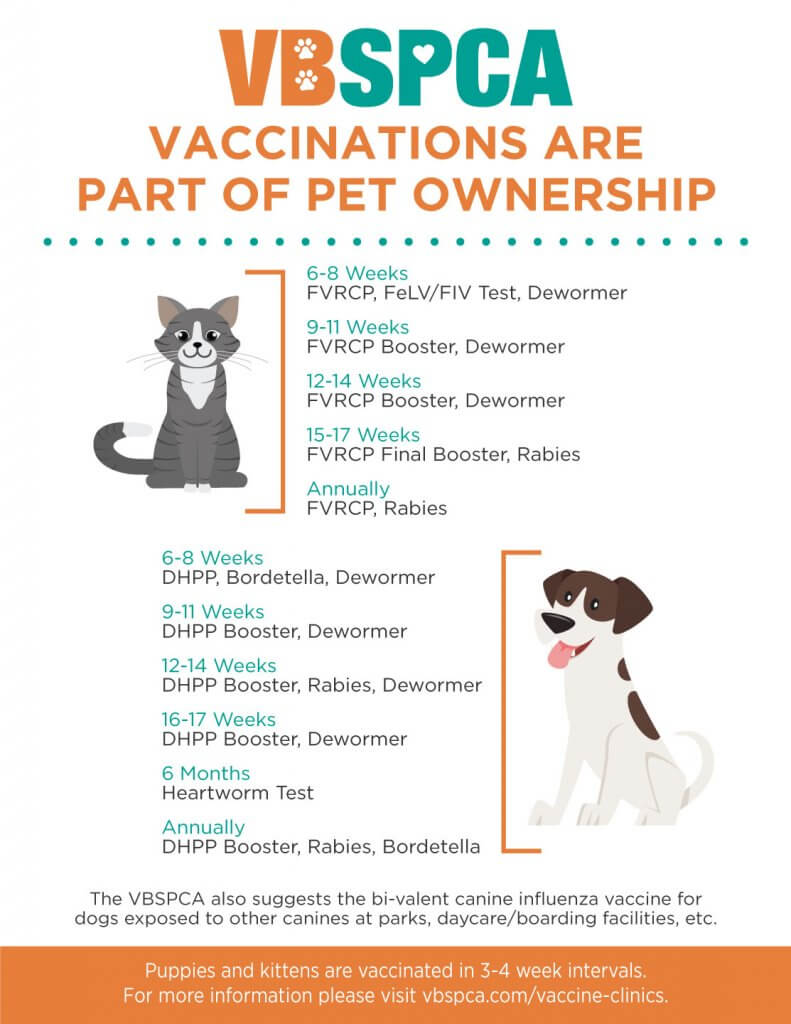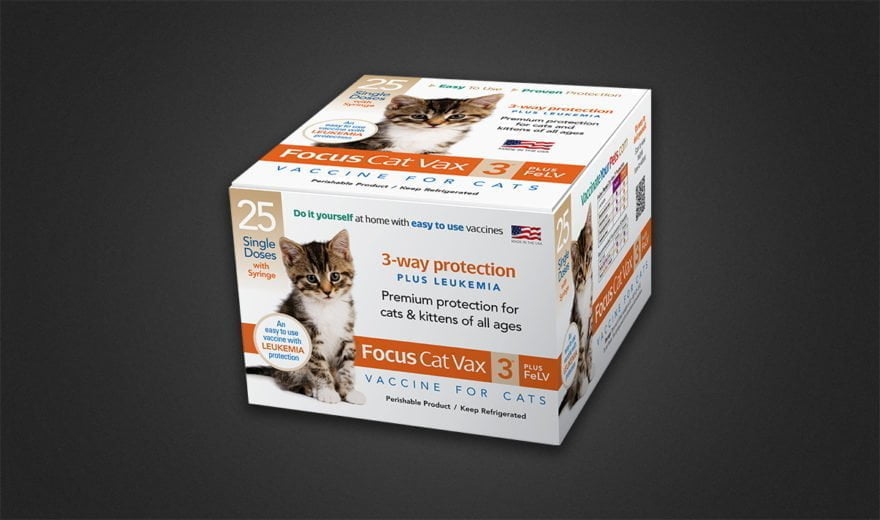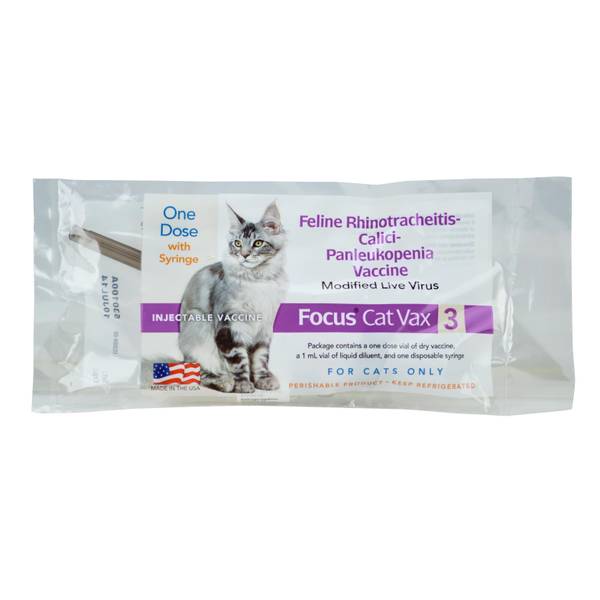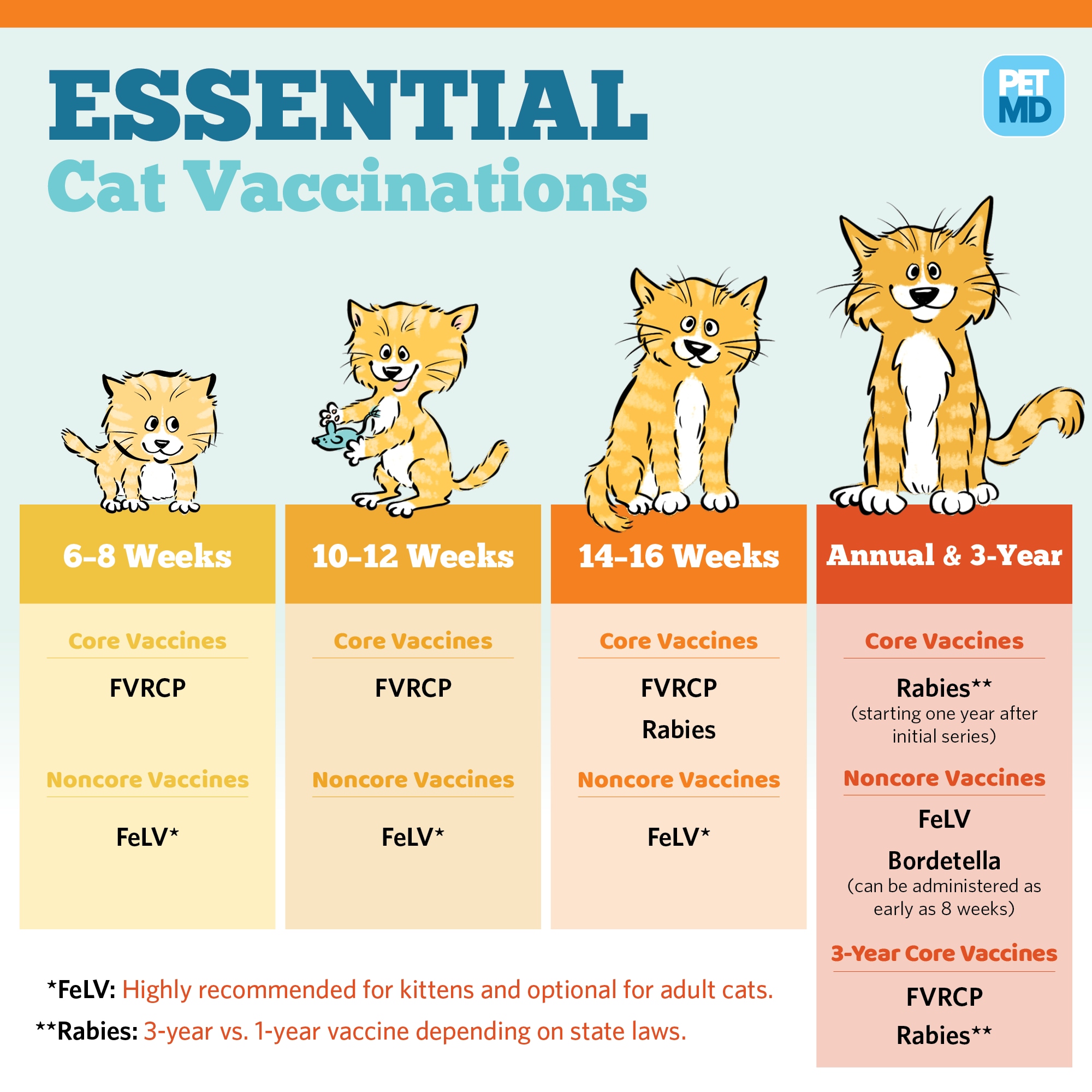cat leukemia vaccine age
When Should Your Cat Get A Feline Leukemia Vaccine. For the juvenile 16 weeks of age dog and cat the initial vaccination series with core vaccines is critical.

Vaccinations Virginia Beach Spca
Age-matched and litter-matched controls developed no antibody to test antigens before the challenge and 100 became persistently viremic after the challenge.

. When to give vaccines. Feline injection site sarcomas FISS have been recognized since the early 1990s. Benefits and Risks Diarrhea Neurological Disorders Feline Vision Problems.
In terms of how often to repeat a dose with a booster shot this is decided by how long protection lasts. FeLV depresses the immune system and tends to lead to persistent infection. Infection rates are significantly higher up to 30 in cats that are ill or otherwise.
A kitten should be vaccinated around nine weeks of age with the important second dose being given at 12 weeks. Most vaccines given to cats including the FeLV vaccine have the. Cats that go outdoors and may.
Kittens should start getting vaccinations when they are 6 to 8 weeks old until they are about 16 weeks old. Young cats and kittens cats that go outdoors and cats that live in. Background epidemiology and pathogenesis.
Suggested Articles Need for Rabies Vaccination for Indoor Cats Feline Leukemia Virus Feline Immunodeficiency Virus Feline Infectious Peritonitis Vaccines are preparations that resemble infectious agents like bacteria or viruses but are not pathogenic disease causing. The cat vaccine Focus Cat Vax 3 Plus FeLV Vaccine is for vaccination of healthy cats 8 weeks of age or older against feline leukemia rhinotracheitis calici and panleukopenia viruses. At the veterinarians discretion based on risk.
During this series a dog or cat can be considered overdue for vaccination if the patient. The leukemia vaccine requires two initial shots given three to four weeks apart a booster after one year and then yearly to every three years after depending on the cats level of risk. Suggested Articles Lymphoma Feline Vaccines.
Feline leukemia FeLV is a retrovirus belonging to the same group of viruses as HIV however it cant infect humans. Feline leukemia virus FeLV Recommended core vaccine for all kittens. For example protection against feline leukemia lasts one year and requires a yearly booster while protection against cat flu lasts for three years.
A booster vaccination one year on is important to enhance the initial level of immunity. 13 Virus neutralizing antibodies VNA are thought to have a role in the recovery of cats from FeLV infection and protection can be passively transferred by immune serum. But for cats who are older than 1 year and are at low risk of exposure the FeLV vaccine is considered a non-core vaccine.
Shown to be effective for vaccination of healthy cats 9 weeks of age or older against feline leukemia viruses. It is much less common in cats nowadays than it used to be with less than 1 of healthy cats infected. Cats of any age can get FeLV but its typically considered a core vaccine for cats under 1 year old.
UC Davis School of Veterinary Medicine. When administered to an animal they train the immune system to protect against these infectious. Annual booster vaccinations are recommended but not necessary for every cat.
For any cat over 16 weeks old whose vaccine history is unknown the initial series consists of two doses given three to four weeks apart. Feline leukemia virus FeLV is a virus that infects only cats. Contemporaneous with the implementation of stricter vaccination recommendations and the development of adjuvanted killed rabies and feline leukemia virus FeLV vaccines pathologists at the University of Pennsylvania began.
Although cat leukemia also known as feline leukemia virus or FeLV can be a difficult virus to manage pets with it can still live happy relatively long lives. Healthy cats should receive two-three doses 3 to 4 weeks apart with the final dose given at 16 weeks of age. The percentage of cats infected varies depending on age health environment and lifestyle.
For this reason initial core kitten vaccinations occur at three- to four-week intervals until the cat is 16-20 weeks old and maternal antibodies are out of the system. A Host of Possible Causes Feline leukemia virus FeLV is one of the most common infectious diseases in cats affecting between 2 and 3 of all cats in the United States. Then they must be boostered a.
Second vaccination with core vaccines. Some cats may not require any boosters after that first year Dr. Duration of immunity is at least 2 years.
Feline leukemia virus or FeLV is one of the most common infectious diseases in cats. Understanding feline leukemia symptoms can help you better care for a cat with this disease. The AAFP vaccination guidelines recommend that low-risk adult cats be vaccinated every three years for the core vaccines and then as determined by your veterinarian for any non-core vaccines.
It is found worldwide and is. Also shown to be effective against persistent viremia in cats exposed to virulent feline leukemia virus. This is due to widespread and effective vaccinations among kittens and cats since the 1990s.
The determinants of susceptibility to FeLV are unknown except that young kittens are fully susceptible while the majority of cats over 16 weeks of age either recover or develop a latent infection. Some vaccine manufacturers have developed approved three-year vaccines for many of the core vaccines. It is recommended that all kittens be vaccinated against FeLV as feline leukemia is almost entirely preventable with two kitten vaccines and a booster one year later.
FeLV is an important cause of anemia in cats and can cause cancers of several types. Third vaccination with core vaccines. Vaccination with the soluble tumor cell antigen vaccine proved successful in preventing the induction of.
Fifty seronegative cats 8-9 weeks old were vaccinated subcutaneously on two occasions three weeks apart with either placebo treatment group T01 Versifel FeLV Vaccine treatment group T02 or Purevax FeLV Vaccine treatment group T03 according to the manufacturers directions. Each of the above core vaccines should be given every 3-4 weeks with the final kitten vaccination administered at 14-16 weeks of age. Give 1 ml subcutaneous.
Canine parvovirus-2 CVP-2 Feline parvovirus FPV or panleukopenia. Kittens should be given an initial vaccine at 8 12 weeks of age and second dose is normally given 3-4 weeks later. Regular boosters throughout a cats life will help maintain a good level of protection against cat flu feline parvovirus and feline leukaemia.

Focus Cat Vax 3 Plus Felv Vaccine 1 Dose With Syringe On Sale Entirelypets Rx

Cat Leukemia Causes Signs Treatment Canna Pet

Focus Cat Vax 3 Plus Felv Durvet

Feline Leukemia Vaccine Felv For Cats Great Pet Care

Cat Leukemia Causes Signs Treatment Canna Pet
/adult-cat-vaccination-schedule-4846632_V4-ff36ccb34d74410d9652b4307a26e8b3.png)
What Is The Average Adult Cat Vaccination Schedule

Vaccinations Eighth Street Veterinary Care

Product Spotlight Focus Cat Vax 3 Plus Felv Durvet

Common Cat Vaccinations And What They Prevent With Schedule Lovetoknow
/adult-cat-vaccination-schedule-4846632_V4-ff36ccb34d74410d9652b4307a26e8b3.png)
What Is The Average Adult Cat Vaccination Schedule

Animal Vaccination Services Kindness Counts Spay Neuter Clinic

Vaccines Cabbagetown Pet Clinic
Feline Leukaemia Virus Infection

Durvet Focus Cat Vax 3 One Dose Vaccine 051666 Blain S Farm Fleet

Feline Vaccination Veterinarian In Nashville Tn Animal Hospital Of West Nashville
Feline Leukemia Virus Vaccination Today S Veterinary Practice


